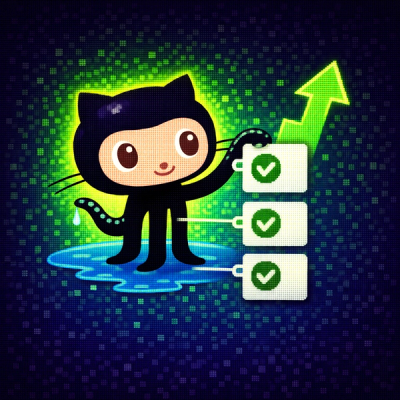
Security News
GitHub Actions Pricing Whiplash: Self-Hosted Actions Billing Change Postponed
GitHub postponed a new billing model for self-hosted Actions after developer pushback, but moved forward with hosted runner price cuts on January 1.
bounded-queue
Advanced tools
Bounded batch queue, where items are produced and consumed based on user specified functions
bounded-queue helps solves the producer–consumer problem.
graph LR;
P(Producer);
B[bounded-queue];
C(Consumer);
P-- batched item -->B;
B-- batched item -->C;
style B fill:#99E,stroke:#333
The bounded-queue allows the producer and consumer to operate in
Imagine you have to read records from a database and write those to another database. A simple way to that move the records is to first read from database A and sequentially write each record to database B.
let batchNr = 0;
let items2produce = 10;
/**
* Mockup database A, producer
*/
const dbA = {
readRecord: async () => {
++batchNr;
console.log("Producing batch #", batchNr);
await new Promise(resolve => setTimeout(resolve, 100));
console.log("Produced batch #", batchNr);
return batchNr;
},
moreRecordsAvailable: () => batchNr < items2produce
}
/**
* Mockup database B, consumer
*/
const dbB = {
async writeRecord(batchNr) {
console.log("Consuming batch #", batchNr);
await new Promise(resolve => setTimeout(resolve, 100));
console.log("Consumed batch #", batchNr);
}
}
/**
* Sequential conversion
*/
async function convertDatabaseRecords() {
while(dbA.moreRecordsAvailable()) {
const record = await dbA.readRecord();
// Consumer
await dbB.writeRecord(record); // expensive async write (consume) operation
}
}
(async () => {
console.time("no-queue");
await convertDatabaseRecords();
console.timeEnd("no-queue");
})();
In the previous example, we either read from database A, or write to database B.
It would be faster if read from database A, while we write to database B, at the same time.
As dbA.readRecord() and dbB.readRecord()areasync` functions, there is no need to introduce threading to accomplish that.
The bounded-queue helps you with that. The following example uses bounded-queue, with a maximum of 3 queued records:
import {queue} from 'bounded-queue';
let batchNr = 0;
let items2produce = 10;
/**
* Mockup database A, producer
*/
const dbA = {
readRecord: async () => {
++batchNr;
console.log("Producing batch #", batchNr);
await new Promise(resolve => setTimeout(resolve, 100));
console.log("Produced batch #", batchNr);
return batchNr;
},
moreRecordsAvailable: () => batchNr < items2produce
}
/**
* Mockup database B, consumer
*/
const dbB = {
async writeRecord(batchNr) {
console.log("Consuming batch #", batchNr);
await new Promise(resolve => setTimeout(resolve, 100));
console.log("Consumed batch #", batchNr);
}
}
/**
* Conversion using bounded-queue
*/
async function convertDatabaseRecords() {
await queue(3, () => {
// Producer
return dbA.moreRecordsAvailable() ? dbA.readRecord() : null; // expenive async read (produce) operation
}, record => {
// Consumer
return dbB.writeRecord(record); // expensive async write (consume) operation
});
}
(async () => {
console.time("bounded-queue");
await convertDatabaseRecords();
console.timeEnd("bounded-queue");
})();
Using the bounded-queue, the conversion will complete in roughly half the time.
npm install bounded-queue
constructor(maxQueueSize: number, producer: Producer<ItemType>, consumer: Consumer<ItemType>)maxQueueSize (number): Maximum number of items that can be in the queue.producer (Producer): A function that produces items to be added to the queue.consumer (Consumer): A function that consumes items from the queue.BoundedQueue instance with the specified maxQueueSize, producer, and consumer.length(): numberrun(): Promise<void>producer function and concurrently consumes items using the consumer function.import { queue } from 'your-module';
// Create and run a BoundedQueue with a maximum queue size of 10
queue(10, producer, consumer)
.then(() => {
console.log('Queue processing completed');
})
.catch((error) => {
console.error('Error during queue processing:', error);
});
queue<ItemType>(maxQueueSize: number, producer: Producer<ItemType>, consumer: Consumer<ItemType>): Promise<void>maxQueueSize (number): Maximum number of items that can be in the queue.producer (Producer): A function that produces items to be added to the queue.consumer (Consumer): A function that consumes items from the queue.BoundedQueue instance. It takes the same parameters as the BoundedQueue constructor and returns a Promise that resolves when all items have been produced and consumed.null indicated the end of the production.import { queue } from 'your-module';
// Create and run a BoundedQueue with a maximum queue size of 10
queue(10, producer, consumer)
.then(() => {
console.log('Queue processing completed');
})
.catch((error) => {
console.error('Error during queue processing:', error);
});
FAQs
Bounded batch queue, where items are produced and consumed based on user specified functions
We found that bounded-queue demonstrated a healthy version release cadence and project activity because the last version was released less than a year ago. It has 1 open source maintainer collaborating on the project.
Did you know?

Socket for GitHub automatically highlights issues in each pull request and monitors the health of all your open source dependencies. Discover the contents of your packages and block harmful activity before you install or update your dependencies.

Security News
GitHub postponed a new billing model for self-hosted Actions after developer pushback, but moved forward with hosted runner price cuts on January 1.

Research
Destructive malware is rising across open source registries, using delays and kill switches to wipe code, break builds, and disrupt CI/CD.

Security News
Socket CTO Ahmad Nassri shares practical AI coding techniques, tools, and team workflows, plus what still feels noisy and why shipping remains human-led.